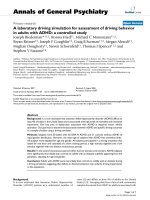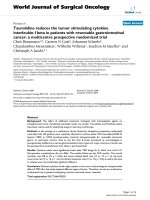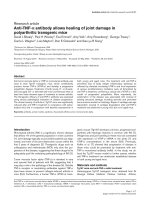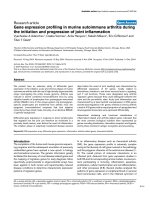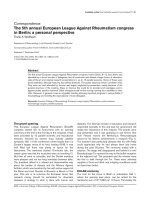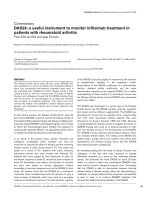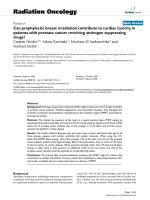Báo cáo y học: "Multi analyte profiling and variability of inflammatory markers in blood and induced sputum in patients with stable COPD" ppsx
Bạn đang xem bản rút gọn của tài liệu. Xem và tải ngay bản đầy đủ của tài liệu tại đây (743.58 KB, 12 trang )
Aaron et al. Respiratory Research 2010, 11:41
/>Open Access
RESEARCH
BioMed Central
© 2010 Aaron et al; licensee BioMed Central Ltd. This is an Open Access article distributed under the terms of the Creative Commons
Attribution License ( which permits unrestricted use, distribution, and reproduction in
any medium, provided the original work is properly cited.
Research
Multi analyte profiling and variability of
inflammatory markers in blood and induced
sputum in patients with stable COPD
Shawn D Aaron*
1
, Katherine L Vandemheen
1
, Timothy Ramsay
1
, Chun Zhang
2
, Zafrira Avnur
2
, Tania Nikolcheva
2
and
Anthony Quinn
2
Abstract
Background: We analyzed serial concentrations of multiple inflammatory mediators from serum and induced sputum
obtained from patients with stable COPD and controls. The objective was to determine which proteins could be used
as reliable biomarkers to assess COPD disease state and severity.
Methods: Forty-two subjects; 21 with stable COPD and 21 controls, were studied every 2 weeks over a 6-week period.
Serum and induced sputum were obtained at each of 3 visits and concentrations of 19 serum and 22 sputum proteins
were serially assessed using multiplex immunoassays. We used linear mixed effects models to test the distribution of
proteins for an association with COPD and disease severity. Measures of within- and between-subject coefficients of
variation were calculated for each of the proteins to assess reliability of measurement.
Results: There was significant variability in concentrations of all inflammatory proteins over time, and variability was
greater for sputum proteins (median intra-subject coefficient of variation 0.58) compared to proteins measured in
serum (median intra-subject coefficient of variation 0.32, P = 0.03). Of 19 serum proteins and 22 sputum proteins
tested, only serum CRP, myeloperoxidase and VEGF and sputum IL-6, IL-8, TIMP-1, and VEGF showed acceptable intra
and inter-patient reliability and were significantly associated with COPD, the severity of lung function impairment, and
dyspnea.
Conclusions: Levels of many serum and sputum biomarkers cannot be reliably ascertained based on single
measurements. Multiple measurements over time can give a more reliable and precise estimate of the inflammatory
burden in clinically stable COPD patients.
Introduction
There is increasing evidence that chronic obstructive pul-
monary disease (COPD) is associated with chronic sys-
temic inflammation as well as inflammation in the
airways and lung parenchyma [1,2]. Previous studies have
used quantitative enzyme-linked sandwich immunoas-
says (ELISA) to measure a limited number of biomarker
proteins and have shown that serum C-reactive protein
levels (CRP), and sputum neutrophil chemo-attractants
such as interleukin-8 (IL-8), and tumor necrosis factor-α
(TNFα), are significantly higher in patients with COPD
compared to controls [3,4]. Newer assay methods, which
use multiplex sandwich ELISA technology, allow mea-
surement of up to 30 cytokines using a single blood sam-
ple, and are thus potentially more useful[5].
A recent meta-analysis of 652 studies showed that only
sputum neutrophils, IL-8, TNFα, and CRP were able to
distinguish between differing stages of COPD disease
severity [6]. However in many of the studies reviewed in
the meta-analysis there is evidence of variability in the
levels of individual inflammatory mediators between sub-
jects. The significance of this heterogeneity is difficult to
ascertain as most studies have focused on identifying dif-
ferences in mediators between COPD patients and con-
trols and have used samples collected at a single time
point. Thus it is unclear whether levels of inflammatory
* Correspondence:
1
Department of Medicine, The Ottawa Health Research Institute, University of
Ottawa, 501 Smyth Road, Ottawa, ON, K1H 8L6, Canada
Full list of author information is available at the end of the article
Aaron et al. Respiratory Research 2010, 11:41
/>Page 2 of 12
mediators vary widely within stable COPD patients over
time. Without knowledge of the inherent variability of the
factor being analyzed, it is difficult to know whether the
protein, measured in blood and sputum, can be used as a
reliable biomarker to assess disease state and disease
severity.
Our study had two major objectives. The first objective
was to use multi-analyte profiling of numerous inflam-
matory proteins in induced sputum and serum to deter-
mine which proteins could be used as reliable biomarkers
to assess COPD disease state and disease severity. The
second objective was to describe the intra- and inter-
patient variability in inflammatory proteins in induced
sputum and serum in patients with stable COPD com-
pared to controls.
Methods
Study subjects
We recruited 4 categories of subjects aged 35 years or
older into this study; 1) Current smokers with COPD, 2)
Former smokers with COPD, 3) Current smokers with no
evidence of COPD or airflow obstruction, and 4) Lifetime
non-smokers with no evidence of COPD or airflow
obstruction. Groups 3 and 4 were control groups. This
design allowed us to assess for current smoking as an
independent risk for altered inflammatory cytokine pro-
files, and allowed us to assess potential interactions of
smoking and disease state. All patients with COPD had to
have at least GOLD stage II-IV COPD and a 10 pack-year
history of smoking. We excluded patients with a history
of COPD exacerbation within one month prior to study
entry, asthma or atopy, patients using chronic oral pred-
nisone, those not able to perform spirometry, and those
subjects with other conditions which may cause inflam-
mation, including; current cancer, infections, rheumatoid
arthritis, lupus, scleroderma, or a recent myocardial
infarction within 3 months. The study was approved by
The Research Ethics Board of The Ottawa Hospital and
all subjects signed written, informed consent.
Study design
This was a prospective cohort study. Subjects were seen
on 3 occasions at 2-week intervals over a 6 week period.
On each visit, patients underwent assessments of mea-
surements of dyspnea intensity using the Baseline Dysp-
nea Index [7] and measurements of respiratory symptoms
(including dyspnea, cough, sputum production) using the
American Thoracic Society Questionnaire [8]. Spirome-
try was performed at each visit along with a clinical
review to ensure clinical stability.
Sample collection
Induced sputum and blood samples were collected at
each visit. Sputum induction was performed according to
previously described protocols [9]. Subjects inhaled 5 mls
of 0.9% saline, 3% saline and 5% saline successively via an
aerosol nebulizer (Flaem Aerosol Universal III) at maxi-
mal output (0.8 ml/min) for five minutes until 2 ml of
sputum was obtained. Sputum quality was assessed using
Gram staining, samples containing >25 squamous epithe-
lial cells per low power field were discarded. Sputum was
diluted with an equal amount of 0.1% dithiothreitol in
Hanks solution and incubated on a rocking platform for
15 min at room temperature to digest mucus. The sus-
pended mixture was allowed to stand at room tempera-
ture for 10 minutes and the sputum digests were
centrifuged at 275 × g to sediment cellular constituents.
Cell supernatants and centrifuged serum were collected
and stored frozen at -70°C. Samples were batched and
shipped on dry ice at the halfway point of the study and at
the study termination. Samples were kept frozen from 1
day up to 3 months. Frozen samples were immediately
thawed on receipt at the laboratory and processed for
assessment of protein levels.
Measurement of analytes
Serum and sputum levels of inflammatory mediators
were measured using two multiplex platforms: Luminex
multi-analyte profiling performed at Rules Based Medi-
cine (Austin, TX) [5,10] and SearchLight, performed at
Pierce Biotechnology (Woburn, MA) [11]. Two comple-
mentary multiplex assays were used since neither plat-
form could assay for all of the biomarkers that were
measured in this study. Proteins chosen for analysis were
those that were thought to have known or potential sig-
nificance in the pathobiology of COPD. Twenty-eight
proteins were assayed for in serum on the subject's first
visit, but 9 proteins (α2-macroglobulin, IL-1β, IL-RA, IL-
15, MMP-2, MMP-9, IL-10, and TNFα) were not mea-
sured serially on all three visits because of serum concen-
trations below the limit of detection of the assays, or
because there was no significant difference on visit 1
between serum levels in COPD patients and in controls.
Twenty-two proteins were serially assayed from sputum.
TNFα and Eotaxin-1 could not be measured in sputum,
because dithiothreitol used for sputum processing inter-
fered with measurements of these cytokines. The total
protein concentration of each individual sputum sample
was determined and sputum biomarker levels were
reported normalized for the sputum total protein con-
centration. Total protein was measured in sputum using
the Coomassie Plus Protein assay. The reagent was added
to the sputum supernatant and absorbance was read at
595 nm.
Data analysis
We tested the distribution of biomarkers for an associa-
tion with COPD using a linear mixed effects model
Aaron et al. Respiratory Research 2010, 11:41
/>Page 3 of 12
including disease (COPD or control), smoking, and the
interaction between disease and smoking as fixed effects,
and visit number within each subject as a random effect
for each protein. A log transformation was used for those
analytes whose concentration distributions were highly
skewed. A second linear mixed effects model was also
constructed adding age and gender into the original
model as covariates to adjust for potential effects of these
variables. We assessed associations between individual
protein levels and lung function and dyspnea using a lin-
ear mixed effect model adjusting for age and gender. In
these models lung function variables and dyspnea scores
were fixed effects and patient visit number (1, 2 or 3) was
modeled as a random effect.
The analytical variation of the measurements was
obtained from the assay manufacturers. Within-subject
coefficient of variation (WCV) and the between-subject
coefficient of variation (BCV) were calculated for each of
the proteins to assess for the intra- and inter-patient vari-
ability respectively in the levels of the inflammatory pro-
teins. The reference change value for each analyte
measurements was calculated from the analytic variation
and the within subject coefficient of variation using the
Harris formula [12]. Bootstrap re-sampling was per-
formed to estimate the 90% confidence intervals of the
within- and between-subject coefficients of variation.
Results
Subject Characteristics
We studied 42 subjects prospectively over a 6-week
period. Twenty-one subjects had COPD; 8 were active
smokers, and 13 were former smokers. Twenty-one con-
trols without COPD were studied; 9 were active smokers
and 12 had never smoked. Patient characteristics of the 4
groups of patients are listed in Table 1, along with their
baseline lung function data. The mean post-bronchodila-
tor FEV1 (after inhalation of 200 ug of salbutamol) was
46% and 44% predicted in the non-smoking and smoking
cohorts with COPD respectively. Lung function was nor-
mal in the control group.
Serum Biomarker Results
Table 2 shows the mean serum concentrations for the
biomarkers averaged over the 3 patient visits. A linear
mixed effects model was fitted for each biomarker. Of the
19 serum proteins that were serially assayed, four (21%)
were found to be significantly associated with COPD.
Serum levels of Eotaxin2, C reactive protein (CRP),
myeloperoxidase and vascular endothelial growth factor
(VEGF) were significantly higher in patients with COPD
compared to controls. Smoking did not exert a confound-
ing effect; these four serum proteins were elevated in
both smokers and non-smokers with COPD compared to
respective controls. Similarly, adjustment for age and
gender did not alter the association between the four
serum markers and presence of COPD. Serum IL-6 and
IL-8 could not be completely assessed since their values
were below the limits of detection of the assay for some
COPD patients and for many of the controls.
Table 3 shows values for within-subject mean coeffi-
cients of variation, between-subject coefficients of varia-
tion, analytical variation and reference change values for
the 19 serum inflammatory proteins in the COPD cohort.
The median within-subject coefficient of variability for
serum proteins was 32%. A minimally acceptable varia-
tion in serum concentrations for each subject (defined as
a within subject CV < 60%) was seen for most proteins
with the exception of Eotaxin2, HGF, and MMP13 which
had within-subject CV values exceeding 60%. Between-
subject variation was also assessed, and results suggest
that MMP13 and ENA 78 had high inter-subject variabil-
ity (>100%) in the concentrations of these proteins
between COPD patients. Serum levels of C reactive pro-
tein (CRP), myeloperoxidase and VEGF, but not
Eotaxin2, showed acceptable intra- and inter-subject
variability. Reference change values for most proteins
(Table 3) were relatively high (median reference change
value = 91%, range 48% to 246%) suggesting that for most
proteins individual measurements in a given patient need
to change by >48% from baseline before a statistically sig-
nificant change in the measurement can be assumed.
In the patients with COPD serum myeloperoxidase and
VEGF were significantly and negatively associated with
the FEV
1
(Table 4). Serum CRP, myeloperoxidase and
VEGF all showed significant associations with patient
dyspnea and were negatively associated with diffusion
capacity.
Sputum Biomarker Results
Table 5 shows the mean sputum concentrations for the
biomarkers retrieved from induced sputum averaged over
the 3 patient visits. Of the 22 sputum proteins that were
serially assayed, 7 (32%) were found to be significantly
associated with COPD. Sputum levels of GROα, TNF RII,
IL-6, IL-8, MCP-1, TIMP1, and VEGF were significantly
higher in patients with COPD compared to controls.
Smoking did not exert a confounding effect; these seven
sputum proteins were elevated in both smokers and non-
smokers with COPD compared to respective controls.
Similarly, adjustment for age and gender did not alter the
association between these seven sputum markers and
presence of COPD.
Table 6 shows values for within-subject and between-
subject mean coefficients of variation for the sputum
inflammatory proteins in the COPD cohort. Repeated
measurements of these proteins over time showed rela-
tively greater variation in sputum concentrations for
most proteins compared to variations in serum protein
Aaron et al. Respiratory Research 2010, 11:41
/>Page 4 of 12
concentrations. The median intra-subject and inter-sub-
ject coefficients of variation were 58% and 79% for spu-
tum proteins respectively, compared to median intra-
subject and inter-subject coefficients of variation of 32%
and 59% for serum proteins (P = 0.03 for each of the two
comparisons). Reference change values for most sputum
proteins (Table 6) were high (median reference change
value = 163%, range 84% to 238%) suggesting that for
most sputum proteins individual measurements in a
given patient need to change by >100% from baseline
before a statistically significant change in the measure-
ment can be assumed.
For the seven sputum proteins associated with COPD,
only IL-6, IL-8, TIMP-1, and VEGF showed acceptable
within-subject and between-subject variability over the
three patient visits (MCV < 0.6 and BCV < 1.0, respec-
tively).
In the patients with COPD the sputum biomarkers IL-
6, IL-8, TIMP-1, and VEGF were significantly and nega-
tively associated with the FEV
1
(Table 7). All four bio-
markers also showed significant association with patient
dyspnea and 3 out of 4 were associated with residual vol-
ume. Only IL-6 was negatively associated with the diffu-
sion capacity.
Table 8 shows the correlation between sputum bio-
marker concentrations and total sputum protein concen-
tration As shown in Table 8, most sputum biomarkers
with the exception of four, exhibited a strong correlation
with total protein.
In a posthoc analysis we compared sputum IL-8 levels
in patients with COPD who reported chronic bronchitis
vs those who did not. Fifteen of the 21 COPD patients
reported a history of chronic bronchitis (Table 1). Spu-
tum IL-8 values were significantly higher in COPD
Table 1: Baseline Characteristics of the Study Subjects:
COPD non-smokers (N = 13) COPD smokers (N = 8) Control non-smokers (N = 12) Control smokers (N = 9)
Mean age (95% CI) 72.8 (69.4-76.3) 62.3 (58.7 - 65.8) 66.7 (62.4-70.9) 56.4 (52.7-60.1)
Female Gender 7 (54%) 5 (63%) 7 (58%) 6 (67%)
Mean BMI (95% CI) 28.3 (25.4-31.2) 25.5 (20.9-30.2) 25.8 (23.9-27.7) 26.0 (24.5-27.6)
Pack Years (95% CI) 44.5 (33.7-55.2) 53.8 (44.5-63.0) 0 29.3 (22.0-36.7)
Post-bronchodilator
FEV1% predicted
46 (39 - 53) 44 (33 - 54) 101 (92-111) 102 (93-111)
GOLD Stage II 6 (46%) 3 (38%) 0 0
GOLD Stage III 6 (46%) 3 (38%) 0 0
GOLD Stage IV 1 (8%) 2 (25%) 0 0
History of Chronic
Bronchitis
7 (54%) 8 (100%) 0 (0%) 3 (33%)
Total lung capacity
% predicted
122 (108 - 136) 117 (106-127) 103 (96-110) 106 (99-114)
Residual volume %
predicted
172 (132 - 211) 176 (150-201) 93 (81-104) 94 (81-108)
Diffusion capacity
(DLCO % predicted
64 (56 - 73) 64 (50-78) 86 (82-90) 78 (71-84)
Baseline Dyspnea
Index Score (95% CI)
6.0 (4.7 - 7.4) 6.5 (4.7 - 8.2) 11.6 (11.2-11.9) 10.9 (10.1-11.6)
Use of inhaled
corticosteroids
10 (77%) 7 (88%) 0 0
Aaron et al. Respiratory Research 2010, 11:41
/>Page 5 of 12
Table 2: Mean serum protein concentrations averaged over the 3 patient visits:
Serum Protein COPD non-smokers
(N = 13)
COPD smokers
(N = 8)
Control non-smokers
(N = 12)
Control smokers
(N = 9)
P value
COPD vs controls
Eotaxin2 (pg/ml)
#
554.2 (352.5) 465.6 (327.4) 364.3 (158.3) 475.5 (766.1) 0.025
IP-10 (pg/ml)
#
170.2 (95.2) 164.8 (126.4) 125.8 (26.4) 100.7 (44.3) 0.22
TNF-R1 (pg/ml)
#
1489.4 (303.0) 1312.1 (257.3) 1430.9 (268.9) 1442.7 (268.0) 0.67
TNF-RII (pg/ml)
#
194.0 (118.8) 268.4 (143.8) 241.9 (116.2) 235.9 (33.9) 0.10
TIMP-2 (pg/ml)
#
25028.7 (5273.1) 27639.6 (4570.7) 30286.8 (4946.8) 26514.6 (6425.1) 0.046
HGF (pg/ml)
#
21112.5 (12544.1) 19937.9 (10785.1) 24076.2 (14625.4) 25125.4 (9975.2) 0.56
KGF (pg/ml)
#
82.1 (34.5) 56.9 (26.0) 65.3 (20.8) 66.1 (15.7) 0.94
MMP-13 (pg/ml)
#
1768.8 (2561.6) 718.9 (450.6) 774.5 (421.6) 733.6 (328.7) 0.58
GROα (pg/ml)
#
123.3 (61.4) 93.4 (33.6) 114.8 (53.0) 113.6 (65.9) 0.21
CRP (ug/ml)* 13.6 (11.4) 7.8 (9.1) 4.1 (3.2) 4.4 (4.0) 0.042
ENA-78 (ng/ml)* 2.3 (2.69) 1.8 (0.6) 2.5 (1.7) 2.9 (1.9) 0.13
IL-13(pg/ml)* 37.5 (7.0) 46.8 (13.4) 40.4 (10.3) 37.9 (7.9) 0.17
IL-18 (pg/ml)* 302.1 (165.4) 329.0 (106.7) 281.9 (170.9) 256.3 (109.1) 0.17
IL-6 (pg/ml)* 8.0 (7.1) 6.4 (5.1) 2.3 (0.7) Below detection
limits
0.20
IL-8 (pg/ml)* 15.1 (12.1) 11.4 (3.7) 11.1 (3.4) 11.5 (3.9) 0.30
MCP-1 (pg/ml)* 279.1 (181.5) 259.7 (101.1) 182.3 (35.6) 198.7 (42.4) 0.16
Myeloperoxidase
(ng/ml)*
523.7 (546.2) 597.9 (298.9) 379.6 (308.8) 430.3 (248.9) 0.031
TIMP-1 (ng/ml)* 162.7 (33.1) 160.7 (21.2) 162.3 (31.5) 146.0 (33.2) 0.61
VEGF (pg/ml)* 753.1 (217.9) 999.5 (826.2) 586.2 (192.1) 674.5 (149.4) 0.035
Values in brackets are the standard deviations of the mean.
P values were assessed using linear mixed effects models adjusted for age and gender (see methods section for details).
# = Measured using SearchLight multiplex sandwich ELISA
* = Measured using Luminex bead- based suspension array assays
IP-10 = interferon-inducible protein 10, TNF-R1 = tumour necrosis factor receptor I, TNF-RII = tumour necrosis factor receptor 2, TIMP-2 = tissue
inhibitors of metalloproteinases 2, HGF = hepatocyte growth factor, KGF = keratinocyte growth factor, MMP-13 = matrix metalloproteinase 13,
GROα = growth-related oncogene alpha, CRP = C-reactive protein, ENA-78 = epithelial neutrophil-activating peptide 78, IL = interleukin, MCP-1
= monocyte chemotactic protein 1, TIMP-1 = tissue inhibitors of metalloproteinases 1, VEGF = vascular endothelial growth factor.
Aaron et al. Respiratory Research 2010, 11:41
/>Page 6 of 12
Table 3: Within-subject and between-subject coefficients of variation, analytical variation and reference change value in
COPD serum samples:
Serum Protein Within-subject CV (%)
(90% CI)
Between-subject CV (%)
(90% CI)
Analytical variation (%) Reference change value (%)
Eotaxin2 64 (55 - 77) 65 (50 - 77) 12.1 180.42
IP-10 49 (44 - 57) 62 (50 - 67) 12.2 139.87
TNF-R1 26 (20 - 33) 20 (13 - 29) 8.8 76.03
TNF-RII 50 (42 - 59) 59 (40 - 68) 8.6 140.53
TIMP-2 21 (17 - 26) 20 (13 - 24) 8.4 62.65
HGF 71 (59 - 84) 56 (37 - 65) 14.3 200.62
KGF 55 (46 - 62) 46 (35 - 57) 8.3 154.08
MMP-13 88 (74 - 103) 151 (57 - 172) 11.0 245.66
GROα 32 (26 - 37) 48 (28 - 56) 8.2 91.50
CRP 53 (40 - 69) 94 (67 - 122) 6.05 147.76
ENA-78 16 (13 - 19) 101 (31 - 120) 4.32 45.91
IL-13 19 (18 - 23) 26 (19 - 30) 3.25 53.39
IL-18 21 (17 - 23) 46 (31 - 54) 3.46 58.95
IL-6 34 (24 - 49) 95 (64 - 111) 3.73 94.74
IL-8 30 (20 - 38) 66 (36 - 79) 3.83 83.77
MCP-1 17 (14 - 20) 56 (35 - 70) 3.95 48.34
Myeloperoxidase 36 (31 - 41) 83 (47 - 103) 5.39 100.83
TIMP-1 16 (14 - 18) 18 (13 - 21) 5.89 47.23
VEGF 19 (14 - 27) 63 (28 - 79) 4.98 54.41
Median coefficient of
variation for all proteins
32 59 6.05 91.05
Aaron et al. Respiratory Research 2010, 11:41
/>Page 7 of 12
patients with chronic bronchits (31.62 ng/mg; SD 35.55)
compared to COPD who did not report chronic cough
and sputum production (11.20 ng/mg; SD 8.40), P = 0.04.
Discussion
We found that multiplex immunoassays were useful in
identifying potential biomarkers in patients with COPD,
and that systemic and sputum biomarkers identified in
these patients were associated with clinical variables
known to predict disease severity. Importantly, we also
showed using repeated measurements over time, that
many biomarkers that are apparently associated with
COPD exhibit a high degree of intra-subject variability,
which renders them relatively unreliable as diagnostic
tests if measured on a single occasion.
To establish a criterion for dynamic assessment of bio-
markers it is first necessary to define when a difference
between two consecutive results indicates a change in a
patient's health status. The most widely accepted
approach for this purpose is to calculate a reference
change value (RCV)
12
. Using serial analytic results from
the same patient for a specific biomarker, it is possible to
calculate the RCV that defines how large a difference
between two consecutive determinations is statistically
significant. The RCV encompasses both biological and
analytical variation. As seen in Tables 3 and 6 the median
RCV values for serum analytes was 91% and for sputum it
was 163%. This suggests that for most analytes individual
measurements in a given patient have to change by
almost 100% (ie. a second measurement must be double,
or half, the value of the first measurement) in order to
assume that there has been a significant change in the
patient's inflammatory status.
Four of 19 serum proteins tested (Eotaxin2, C reactive
protein, myeloperoxidase and VEGF) were elevated in
patients with COPD compared to control subjects. How-
ever of these proteins only CRP, myeloperoxidase and
VEGF showed acceptable coefficients of variation to sug-
gest they were sufficiently reliable over repeated mea-
surements, and hence clinically useful as reliable
predictors to assess disease state. These were also the
only three proteins that showed significant correlations
with FEV
1
, dyspnea, and diffusion capacity, suggesting
that higher serum levels of these proteins are found in
patients with more advanced lung disease.
Our study also found that seven proteins from induced
sputum were significantly elevated in COPD subjects
compared to controls, however of these seven sputum
proteins only four (IL-6, IL-8, TIMP-1, and VEGF)
showed acceptable intra and inter-patient reliability. We
again found significant correlations of these four proteins
with measures of lung function, air-trapping and dysp-
nea.
It should be noted that sputum biomarker levels were
reported normalized for the sputum total protein con-
centration. We corrected for total sputum protein con-
centration in order to overcome variability associated
with sample dilution of induced sputum. All of our spu-
tum analytes except four showed a significant correlation
with total protein. The failure of these four to correlate
with total protein concentration suggests dilution alone
does not account for the differences seen. However there
is also a potential drawback to this method since airway
inflammation may increase local production of cytokines
as well as protein leakage into the airway from the inter-
stitium. If total protein in the airway is increased due to
inflammation, correction of individual biomarkers for
total protein concentration will dampen the inflamma-
tory biomarker signal. However we felt that it was impor-
tant to be conservative and to correct for any variability
in dilution of sputum which is likely to be large.
Our study findings are somewhat complementary to
those of a recently published study by Sapey and col-
leagues [13]. These investigators repeatedly measured IL-
1beta, TNF alpha, IL-8, myeloperoxidase, LKTB-4 and
growth-related oncogene alpha from the spontaneous
sputum of 14 patients with COPD. They showed that
there was significant intra and inter-patient variability in
all of these sputum inflammatory indices which could be
reduced by using a 5 day rolling mean of individual
patient data points. Results of our study are similar to
Sapey's in that we also found significant intra- and inter-
patient variability in repeated measurements of sputum
inflammatory markers. However our study differs from
the Sapey study since we used induced rather than spon-
taneous sputum. We also evaluated serum biomarkers,
Table 4: Serum biomarkers found to be reliable and predictive of COPD: P values for linear mixed effects models
demonstrating associations between serum biomarker concentrations and lung function and dyspnea.
Serum Biomarker Post-bronchodilator FEV1 Diffusion capacity (% predicted) Baseline dyspnea index score
CRP 0.13 0.02 0.03
Myeloperoxidase 0.03 0.009 0.008
VEGF 0.05 0.004 0.003
Aaron et al. Respiratory Research 2010, 11:41
/>Page 8 of 12
Table 5: Mean induced sputum protein concentrations averaged over the 3 patient visits:
Sputum Protein COPD non-smokers COPD smokers Control non-smokers Control smokers P value
COPD vs controls
Eotaxin2 (pg/mg)
#
1244.2 (1638.6) 808.9 (349.6) 297.8 (279.1) 1159.5 (1477.7) 0.16
HGF (ng/mg)
#
19.2 (15.4) 18.0 (17.0) 7.6 (5.9) 23.3 (20.9) 0.61
IP-10 (pg/mg)
#
1015.3 (814.8) 605.8 (393.0) 395.7 (272.9) 480.6 (988.8) 0.94
KGF (pg/mg)
#
771.5 (747.7) 881.4 (851.5) 549.9 (516.4) 1490.1 (1256.2) 0.67
MMP-13 (ng/mg)
#
29.5 (25.8) 30.9 (23.8) 15.1 (11.7) 45.8 (38.7) 0.99
TNF-RI (pg/mg)
#
2459.5 (1548.9) 2635.7 (2280.7) 1390.2 (1241.6) 3671.3 (2806.4) 0.77
GROα (ng/mg)
#
54.9 (63.8) 23.3 (18.3) 7.6 (9.6) 15.7 (14.6) 0.007
TIMP2 (ng/mg)
#
21.1 (9.2) 18.6 (17.0) 5.8 (5.9) 11.8 (14.4) 0.09
TNF-RII (pg/mg)
#
169.1 (113.9) 255.9 (367.0) 46.7 (42.1) 130.4 (129.8) 0.04
α2 macroglobulin (mg/mg)* 0.008 (0.006) 0.004 (0.002) 0.005 (0.003) 0.06 (0.07) 0.09
ENA-78 (ng/mg)* 3.7 (4.1) 1.9 (1.7) 1.4 (1.6) 1.2 (0.8) 0.36
IL-13 (pg/mg)* 21.3 (31.2) 9.3 (7.1) 8.6 (1.9) 5.7 (1.7) 0.92
IL-15 (ng/mg)* 0.17 (0.32) 0.11 (0.10) 0.08 (0.03) 0.04 (0.02) 0.47
IL-18 (pg/mg)* 160.4 (189.8) 118.9 (74.4) 58.4 (39.1) 100.8 (53.2) 0.32
IL-1β (pg/mg)* 142.6 (170.7) 404.3 (701.8) 22.8 (12.3) 53.2 (23.1) 0.06
IL-1RA (ng/mg)* 87.3 (53.1) 107.6 (87.4) 60.7 (36.1) 130.0 (72.1) 0.64
IL-6 (pg/mg)* 156.5 (182.3) 214.4 (194.7) 13.3 (7.9) 100.8 (88.4) 0.00005
IL-8 (ng/mg)* 13.6 (9.0) 32.7 (35.2) 3.5 (3.0) 9.0 (8.8) 0.005
MCP-1 (pg/mg)* 845.2 (1285.2) 692.2 (957.0) 71.3 (54.6) 237.2 (318.6) 0.01
MMP-2 (ng/mg)* 55.3 (37.9) 41.3 (20.4) 60.1 (71.6) 42.3 (20.5) 0.06
TIMP-1 (ng/mg)* 206.6 (71.5) 193.4 (68.9) 75.5 (70.5) 112.3 (83.5) 0.004
VEGF(pg/mg)* 2653.0 (659.6) 2845.7 (1013.8) 1200.4 (706.5) 1733.6 (819.8) 0.006
Values in brackets are the standard deviations of the mean.
P values were assessed using linear mixed effects models adjusted for age and gender (see methods section for details).
All individual sputum protein values are corrected for total sputum protein concentration.
# = Measured using SearchLight multiplex sandwich ELISA
* = Measured using Luminex bead- based suspension array assays
HGF = hepatocyte growth factor, IP-10 = interferon-inducible protein 10, KGF = keratinocyte growth factor, MMP-13 = matrix metalloproteinase 13, TNF-R1 = tumour
necrosis factor receptor I, GROα = growth-related oncogene alpha, TIMP-2 = tissue inhibitors of metalloproteinases 2, TNF-RII = tumour necrosis factor receptor 2,
ENA-78 = epithelial neutrophil-activating peptide 78, IL = interleukin, IL-1RA = interleukin 1 receptor antagonist, MCP-1 = monocyte chemotactic protein 1, MMP-2 =
matrix metalloproteinase 2, TIMP-1 = tissue inhibitors of metalloproteinases 1, VEGF = vascular endothelial growth factor.
Aaron et al. Respiratory Research 2010, 11:41
/>Page 9 of 12
Table 6: Within-subject and between-subject coefficients of variation, analytical variation, reference change value in
COPD induced sputum samples:
Sputum Protein Within-subject CV (%)
(90% CI)
Between-subject CV (%)
(90% CI)
Analytical variation
(%)
Reference change
value (%)
Eotaxin2 70 (53 - 95) 88 (50 - 104) 12.1 196.77
HGF 58 (44 - 76) 66 (46 - 79) 14.3 165.47
IP-10 62 (45 - 82) 54 (32 - 73) 12.2 175.03
KGF 49 (33 - 70) 90 (58 - 126) 8.3 137.66
MMP-13 54 (36 - 72) 69 (43 - 89) 11.0 152.65
TNF-RI 46 (36 - 54) 56 (40 - 65) 8.8 129.73
GROα 78 (56 - 100) 89 (52 - 106) 8.2 217.25
TIMP2 81 (57- 101) 57 (38 - 77) 8.4 225.57
TNF-RII 69 (49 - 89) 104 (65 - 126) 8.6 192.61
α2 macroglobulin 57 (33 - 75) 70 (47 - 84) 6.43 158.89
ENA-78 61 (49 - 74) 88 (60 - 104) 4.32 169.39
IL-13 30 (23 - 37) 101 (32 - 116) 3.25 83.59
IL-15 62 (48 - 76) 121 (64- 149) 3.96 172.09
IL-18 55 (43 - 66) 63 (32 - 73) 3.46 152.65
IL-1β 61 (44 - 77) 160 (113 - 210) 4.58 169.45
IL-1RA 58 (46 - 69) 55 (37 - 68) 5.86 161.48
IL-6 50 (36 - 68) 99 (59 - 118) 3.73 138.88
IL-8 60 (47 - 82) 88 (70 - 106) 3.83 166.54
MCP-1 86 (70 - 99) 146 (84 - 182) 3.95 238.47
MMP-2 57 (39 - 81) 70 (38 - 82) 3.33 158.16
TIMP-1 54 (33- 73) 38 (27 - 46) 5.89 150.47
VEGF 42 (32 - 55) 24 (15 - 31) 4.98 117.15
Median coefficient of
variation for all proteins
58 79 5.88 163.47
Aaron et al. Respiratory Research 2010, 11:41
/>Page 10 of 12
Table 7: Sputum biomarkers found to be reliable and predictive of COPD: P values for linear mixed effects models
demonstrating associations between sputum biomarker concentrations and lung function and dyspnea.
Sputum Biomarker Post-bronchodilator
FEV1
Residual Volume (%
predicted)
Diffusion capacity (%
predicted)
Baseline dyspnea index
score
IL-6 0.0009 0.007 0.01 0.0007
IL-8 0.03 0.24 0.34 0.037
TIMP-1 0.004 0.01 0.07 0.009
VEGF 0.03 0.01 0.15 0.04
and we compared sputum and serum results from COPD
patients to control subjects.
Results from our study suggest that variability in serum
inflammatory biomarkers is somewhat less than that seen
in biomarkers from induced sputum. This finding makes
intuitive sense, since the amount of sputum yielded from
the lower respiratory tract, and its purulence and relative
dilution, can vary in clinically stable subjects from day to
day. Correction of results by normalizing for the sputum
total protein concentration, such as we did, can partially,
but not completely account for variability in sputum
yields. In contrast, peripheral blood analysis, which yields
a standard amount of serum, is less subject to variability
in sampling, and this may explain why inflammatory pro-
tein measurements are more reproducible from serum
than from induced sputum.
Previous studies have associated serum values of CRP
with COPD [3,14]., and CRP has been used as a clinical
marker to predict an increased risk of COPD exacerba-
tions [15]. Our study confirmed that serum CRP is signif-
icantly elevated in COPD subjects relative to controls.
However we also showed similar associations for serum
VEGF (vascular endothelial growth factor) and myeloper-
oxidase. Both these biomarkers are associated with
destruction and repair of lung tissue. VEGF is a potent
mediator of angiogenesis which appears to be involved in
the development of abnormal pulmonary vascular
remodeling in COPD [16,17], and myeloperoxidase is a
marker of neutrophil activation and inflammation
[18,19]. In our study these biomarkers correlated signifi-
cantly with FEV1, dyspnea, and impairments in diffusion
capacity, suggesting that elevation in concentrations of
these serum biomarkers may be reflective of ongoing lung
destruction, emphysema, and alveolar remodeling.
A previous study by Gompertz and colleagues sug-
gested that the sputum inflammatory markers neutrophil
elastase and IL-8 were significantly elevated in COPD
patients with alpha-1 antitryspin deficiency and chronic
sputum expectoration compared to levels in similar
patients who did not chronically expectorate [20]. Our
study similarly suggests that patients with a baseline his-
tory of chronic bronchitis (defined as chronic cough and
sputum production for at least 3 months in the previous 2
years) had higher sputum IL-8 values compared to those
COPD patients who did not report chronic cough and
sputum and this should be borne in mind when analyzing
data from COPD subjects.
There are some limitations to our study. Other sputum
inflammatory markers aside from IL-8 may potentially
also be higher in the subgroup of COPD patients with
chronic bronchitis, however our study did not have ade-
quate patient numbers or power to explore the associa-
tion of sputum analytes in the chronic bronchitis
subgroup in greater detail. We did not perform high-res-
olution CT scans in our patients to quantitatively
describe their degree of emphysema. This would have
been useful, in order to try to better phenotype our
patients, and in order to relate relative levels of serum
biomarkers to CT scan findings of emphysema. Also we
did not test for all of the possible proteins that might par-
ticipate in the complex inflammatory mechanisms that
underlie COPD. Other potential limitations relate to
potential sources of variability in measurements. Serum
and sputum samples were frozen and batched, and a vari-
able duration of freezing, and the freeze-thaw cycle, may
introduce variability in measurement values. Two com-
plementary multiplex assays were used, and each plat-
form has its own analytical variation of measurement for
each protein. Although we performed spiking experi-
ments for serum proteins, spiking experiments were not
performed to measure the same proteins in sputum
supernatants. It is possible that the coefficient of varia-
tion for analytes measured in serum may not be applica-
ble to that measured in sputum if the biologic fluid affects
the assay. Finally, our sample size of 42 subjects was rela-
tively small, and an increase in sample size would be
Aaron et al. Respiratory Research 2010, 11:41
/>Page 11 of 12
expected to improve the precision around the estimates
of mean analyte values in patients with COPD.
Conclusion
The acceptability of single biomarker measurements can
only be interpreted in the context of total variability of
the measurements over time. Based on relatively high
intra-subject variability and large reference change values
for individual biomarkers measurements seen in this
study, we would conclude that levels of many serum and
sputum biomarkers cannot be reliably ascertained based
on single measurements, and that multiple measure-
ments over time can give a more reliable and precise esti-
mate of the inflammatory burden in clinically stable
patients.
Our study did identify 3 biomarkers from serum and 4
biomarkers from sputum that were significantly associ-
ated with COPD, and with COPD disease severity.
Importantly, all of these biomarkers also showed accept-
able inter- and intra-subject reliability over repeated
measurements. Increasing use of multiplexed immunoas-
say technology may help to identify new clusters of
important biomarkers that may be associated with ongo-
ing lung inflammation of COPD.
Abbreviations
COPD: chronic obstructive pulmonary disease; TNF alpha: tumor necrosis fac-
tor alpha; IP-10: interferon-inducible protein 10; TNF-R1: tumor necrosis factor
receptor I; TNF-RII: tumor necrosis factor receptor 2; TIMP-2: tissue inhibitors of
metalloproteinases 2; HGF: hepatocyte growth factor; KGF: keratinocyte
growth factor; MMP-2: matrix metalloproteinase 2; MMP-13: matrix metallopro-
teinase 13; GROα: growth-related oncogene alpha; CRP: C-reactive protein;
ENA-78: epithelial neutrophil-activating peptide 78; IL: interleukin; MCP-1:
monocyte chemotactic protein 1; TIMP-1: tissue inhibitors of metalloprotei-
nases 1; VEGF: vascular endothelial growth factor; IP-10: interferon-inducible
protein 10; KGF: keratinocyte growth factor
Competing interests
SDA has no competing interests.
KLV has no competing interests.
TR has no competing interests.
CZ, ZA, TN and AQ are employees of Roche Pharmaceutical Inc.
Authors' contributions
SA and KV designed the study and collected the patient data. SA wrote the first
draft of the paper.
TR and CZ performed the statistical analysis of the data and edited the paper.
ZA, TN, and AQ helped design the study, coordinated assays of the blood and
sputum samples, and edited the paper. All authors have read and approved
the final manuscript.
Acknowledgements
Supported by an unrestricted grant from Roche Pharmaceuticals Inc.
Author Details
1
Department of Medicine, The Ottawa Health Research Institute, University of
Ottawa, 501 Smyth Road, Ottawa, ON, K1H 8L6, Canada and
2
Roche
Pharmaceuticals CRED, Roche Palo Alto, 3431 Hillview Ave, A2-246 Palo Alto, CA
94304 USA
Received: 22 April 2009 Accepted: 22 April 2010
Published: 22 April 2010
This article is available from: 2010 Aaron et al; licensee BioMed Central Ltd. This is an Open Access article distributed under the terms of the Creative Commons Attribution License ( which permits unrestricted use, distribution, and reproduction in any medium, provided the original work is properly cited.Respiratory Research 2010, 11:41
Table 8: Correlation between sputum biomarker concentration
and total sputum protein concentration.
Sputum Protein Spearman's correlation
coefficient (Rho)
P value
Eotaxin2 0.70 0.0005
HGF 0.59 0.003
IP-10 0.57 0.005
KGF 0.37 0.07
MMP-13 0.58 0.004
TNF-RI 0.64 0.002
GROα 0.65 0.001
TIMP2 0.69 0.0006
TNF-RII 0.67 0.0009
α2 macroglobulin 0.51 0.01
ENA-78 0.44 0.03
IL-13 -0.26 0.19
IL-15 -0.18 0.37
IL-18 0.54 0.007
IL-1β 0.69 0.0006
IL-1RA 0.39 0.05
IL-6 0.64 0.001
IL-8 0.70 0.0005
MCP-1 0.69 0.0006
MMP-2 0.26 0.20
TIMP-1 0.55 0.006
VEGF 0.61 0.002
Aaron et al. Respiratory Research 2010, 11:41
/>Page 12 of 12
References
1. Di Stefano A, Turato G, Maestrelli P, Mapp CE, Ruggieri MP, Roggeri A:
Airflow limitation in chronic bronchitis is associated with T-
lymphocyte and macrophage infiltration of the bronchial mucosa.
American Journal of Respiratory & Critical Care Medicine 1996,
153(2):629-632.
2. Thompson AB, Daughton D, Robbins RA, Ghafouri MA, Oehlerking M,
Rennard SI: Intraluminal airway inflammation in chronic bronchitis.
Characterization and correlation with clinical parameters. American Review
of Respiratory Disease 1989, 140(6):1527-1537.
3. Pinto-Plata VM, Mullerova H, Toso JF, Feudjo-Tepie M, Soriano JB, Vessey
RS: C-reative protein in patients with COPD, control smokers and non-
smokers. Thorax 2006, 61:23-28.
4. Keatings VM, Collins PD, Scott DM, Barnes PJ: Differences in interleukin-8
and tumor necrosis faxtor-α in induced sputum from patients with
chronic obstructive pulmonary disease or asthma. American Journal of
Respiratory and Critical Care Medicine 1996, 153:530-534.
5. Fulton RJ, McDade RL, Smith PL, Kienker LJ, Kettman JR: Advanced
multiplexed analysis with the FlowMetrix system. Clinical Chemistry
1997, 43(9):1749-1756.
6. Franciosi L, Page CP, Celli B, Cazzola M, Walker M, Danhof M: Markers of
disease severity in chronic obstuctive pulmonary disease. Pulmonary
Pharmacology & Therapeutics 2006, 19:189-199.
7. Mahler DA, Weinberg DH, Wells CK, Feinstein AR: The measurement of
dyspnea. Contents, interobserver agreement, and physiologic
correlates of two new clinical indexes. Chest 1984, 85:751-758.
8. Ferris BG: Epidemiology Standardization Project. Am Rev Respir Dis 1978,
118(6 pt 2):1-88.
9. Kips JC, Inman MD, Jayaram L, Bel EH, Parameswaran K, Pizzichini MM: The
use of induced sputum in clinical trials. European Respiratory Journal -
Supplement. 2002, 37:47s-50s.
10. Carson RT, Vignali DA: Simultaneous quantitation of 15 cytokines using
a multiplexed flow cytometric assay. Journal of Immunological Methods
1999, 227(1-2):41-52.
11. Moody M, Van Arsdell S, Murphy K, Orencole S, Burns C: Array-based
ELISAs for high-throughput analysis of human cytokines. Biotechniques
2001, 31:186-190.
12. Harris EK, Yasak T: On the calculation of a 'reference change' for
comparing two consecutive measurements. Clin Chem 1983, 29:25-30.
13. Sapey E, Bayley D, Ahmad A, Newbold P, Snell N, Stockley R: Inter-
relationships between inflammatory markers in patients with stable
COPD with bronchitis: intra-patient and inter-patient variability.
Thorax 2008, 63:493-503.
14. Man S, Connett JE, Anthonisen NR, Wise RA, Tashkin D, Sin D: C-reactive
protein and mortality in mild to moderate chronic obstructive
pulmonary disease. Thorax 2006, 61:849-853.
15. Perera W, Hurst JR, Wilkinson TMA, Sapsford R, Mullerova H, Donaldson
GC: Inflammatory changes, recovery and recurrence at COPD
exacerbation. Eur Respir J 2007, 29:527-534.
16. Kanazawa H, Asai K, Nomura S: Vascular endothelial growth factor as a
non-invasive marker of pulmonary vascular remodeling in patients
with bronchitis-type of COPD. Respiratory Research 2007, 8(22):.
17. Siafakas N, Antoniou K, Tzortzaki E: Role of angiogenesis and vascular
remodeling in chronic obstructive pulmonary disease. Int J of COPD
2007, 2(4):453-462.
18. Andelid K, Bake B, Rak S, Linden A, Rosengren A, Ekberg-Jansson A:
Myeloperoxidase as a marker of increasing systemic inflammation in
smokers without severe airway symptoms. Respir Med 2007,
101:888-895.
19. Barczyk A, Sozanska E, Trzaska M, ala W, Pierzchala W: Decreased levels of
myeloperoxidase in induced sputum of patients with COPD after
treatment with oral glucocorticoids. Chest 2004, 126:389-393.
20. Gompertz S, Hill AT, Bayley DL, Stockley RA: Effect of expectoration on
inflammation in induced sputum in alpha-1 antitrypsin deficiency.
Resp Medicine 2006, 100:1094-1099.
doi: 10.1186/1465-9921-11-41
Cite this article as: Aaron et al., Multi analyte profiling and variability of
inflammatory markers in blood and induced sputum in patients with stable
COPD Respiratory Research 2010, 11:41

